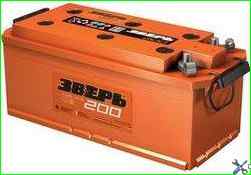ZIL cars and buses are equipped with two 6ST-110A or similar batteries connected in series
Technical characteristics of batteries:
Nominal voltage, V 12
Nominal capacity at 20-hour discharge mode, Ah 110
Discharge current at 10-hour mode, A 10
Starter discharge current, A 470
Charging current, A 11
Amount of electrolyte for filling one battery, l 7.5
Material of battery monoblocks plastic
Material of separators Mineral plastic and fiberglass
Overall dimensions, mm: length 322, width 215, height 230, weight (with electrolyte), kg 33.89

One, main battery, connected to the battery switch, powers all electrical equipment of the car, except for the starter circuits.
The second, additional battery, serves to create 24 V in the network and is designed to start the engine with a starter.
The additional battery is charged from the generator automatically through the transformer-rectifier unit (TRU).
By As the main battery wears out naturally, it is permissible to swap the batteries.
During each vehicle maintenance, it is necessary to check the reliability of the battery fastening, the tightness of the contact of the terminals, clean them from dirt, check the electrolyte level, which should be between the "min" and "max" marks on the battery case.
The following requirements must be met when operating the vehicle
The battery must not be disconnected when the engine is running to avoid damage to the generator diodes and other semiconductor devices.
The battery must not be connected to the network, even briefly, by connecting the positive terminal of the generator to the negative terminal of the battery.
The wires to the generator and voltage regulator must be connected in strict accordance with the markings on these products.
All work on repairing and replacing electrical equipment should be carried out only after disconnecting the battery terminals from the power supply car.
This should also be done when recharging batteries from an external power source.
Removing and installing batteries
Working with batteries requires mandatory compliance with safety precautions, since the electrolyte used for acid batteries can cause poisoning, burns and damage to clothing.
To remove batteries from a car, turn off the battery switch, remove the protective covers behind the footrests by unscrewing the bolts that secure them.
Unscrew the bolts that secure the terminals to the battery poles and manually install the batteries on the trolley for transporting them.
Installing batteries is done in the reverse order.
Requirements for batteries
In a fully charged battery, the voltage at the "+" and "-" terminals without load (emf) should be at least 12.72 B, after checking with a load fork for 5 s, it should not fall below 10.2-10.8 V.
The voltage difference in individual battery cells should not exceed 0.1 V, and the difference in electrolyte density should not exceed 0.01 g / cm 3.
A battery that does not meet the listed requirements must be sent to a charging station for a final decision on its suitability for further use.
The density of the electrolyte for the proper operation of the battery is of primary importance: the density of the electrolyte, the voltage on individual battery cells and the cleanliness of the terminals.
The density of the electrolyte is not a constant value, it changes depending on temperature conditions.
Since the chemical composition of the electrolyte, necessary for the normal operation of the battery, remains the same almost all the time, in areas with a cold climate, more electrolyte should be poured into the batteries high density, and in areas with a hot climate (tropics) - an electrolyte of lower density (table).
In summer, the water contained in the electrolyte evaporates actively, so to maintain the required level of electrolyte and prevent an increase in density, it is necessary to add distilled water to the battery.
In winter, the battery should be serviced more thoroughly.
The density of the electrolyte should be checked more often, since at low temperatures, low-density electrolyte can freeze.
The table shows the freezing point of the electrolyte depending on its density.
Electrolyte freezing point table
Electrolyte density reduced to 15°C - Tempe freezing point, °C (minus)
- 1,050 - 3
- 1,075 - 5
- 1,100 - 7
- 1,125 - 10
- 1,150 - 14
- 1,170 - 19
- 1,200 - 25
- 1,225 - 37
- 1,250 - 50
- 1,275 - 59
- 1,300 - 63
- 1,310 - 66
When operating the vehicle with a decrease in the electrolyte level in the battery should be filled with distilled water, bringing the level to the norm.
In the cold season, to avoid freezing, distilled water should be added only before starting the engine.
You can add electrolyte or acid to the batteries only if you know for sure that the electrolyte level has dropped due to its splashing.
The density of the added electrolyte should be the same as that of the electrolyte in the batteries before splashing.
When adding, do not use a metal funnel.
ATTENTION!
Do not use light sources with an open flame to illuminate the batteries during their maintenance, to avoid ignition of the gas emitted by the batteries.





